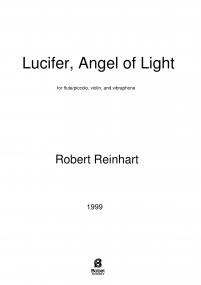Recherche avancée
Convolutional Emergence
7,21 €
Version numérique (+0,00 €) à télécharger
Version papier (+14,80 € impression et livraison ). Colissimo7-14 days aprox.
Chez BabelScores, quand vous achetez une partition, vous pouvez ensuite contacter directement le compositeur ici même !
Caractéristiques
Region
Europe
Estimated Duration
6 - 10min
Date
2013
ISMN : 979-0-2325-1449-9
In Stock
Notes sur cette pièce
Convolutional Emergence (2013)
"Every resultant is either a sum or a difference of the co-operant forces; their sum, when their directions are the same. The emergent is unlike its components insofar as these are incommensurable, and it cannot be reduced to their sum or their difference." G. H. Lewes. "... the totality is not, as it were, a mere heap, but the whole is greater than the sum of the parts...." Aristotle, Metaphysics. Convolution is a mathematical operation on two functions, producing a third function. In music convolution is the imposition of a spectral or rhythmic structure on a sound. Often this envelope or structure is taken from another sound. I use this method as a basis to create a third, or invisible, layer of sound through the piece. The sum of such byproducts eventually function as an emergent and create a blend as a whole. Alongside with inner layers of music functionality, such as rise and fall in tension or emotions. In a simple word, the convulution in this piece could work as a mean of substitute for counter-point. Emergence is the way complex systems and patterns arise out of a multiplicity of relatively simple interactions. An emergent property can appear when a number of simple entities operate in an environment, forming more complex behaviors as a collective. The complex behaviour or properties are not a property of any single such entity. The shape and behaviour of a flock of birds or school of fish are good examples.
Blitz, David. (1992). Emergent Evolution: Qualitative Novelty and the Levels of Reality.Lewes, G. H. (1875), Problems of Life and Mind.Zölzer, Udo, ed. (2002). DAFX:Digital Audio Effects
Ajouter à une playlist
- Identifiez-vous pour créer une liste
Convolutional Emergence (2013)
"Every resultant is either a sum or a difference of the co-operant forces; their sum, when their directions are the same. The emergent is unlike its components insofar as these are incommensurable, and it cannot be reduced to their sum or their difference." G. H. Lewes. "... the totality is not, as it were, a mere heap, but the whole is greater than the sum of the parts...." Aristotle, Metaphysics. Convolution is a mathematical operation on two functions, producing a third function. In music convolution is the imposition of a spectral or rhythmic structure on a sound. Often this envelope or structure is taken from another sound. I use this method as a basis to create a third, or invisible, layer of sound through the piece. The sum of such byproducts eventually function as an emergent and create a blend as a whole. Alongside with inner layers of music functionality, such as rise and fall in tension or emotions. In a simple word, the convulution in this piece could work as a mean of substitute for counter-point. Emergence is the way complex systems and patterns arise out of a multiplicity of relatively simple interactions. An emergent property can appear when a number of simple entities operate in an environment, forming more complex behaviors as a collective. The complex behaviour or properties are not a property of any single such entity. The shape and behaviour of a flock of birds or school of fish are good examples.
Blitz, David. (1992). Emergent Evolution: Qualitative Novelty and the Levels of Reality.Lewes, G. H. (1875), Problems of Life and Mind.Zölzer, Udo, ed. (2002). DAFX:Digital Audio Effects
Instrumentation
violin|Percussions|
Score Details
Format - A3 / tabloid
Pages - 22
Pages - 22





